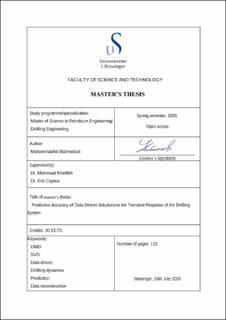| dc.description.abstract | One of the utmost desires of the drilling industry is full drilling automation to minimize well construction cost, optimize well performance and many other advantages. Dynamical system modeling and control of complex systems is undergoing a renaissance, with appearance of data-driven approaches as a result of unprecedently availability of high-fidelity measurements from historical records, numerical simulations and experimental data. In this master thesis, one of modal decomposition techniques called Dynamic Mode Decomposition (DMD), a data-driven regression and machine learning method, is introduced and performance of the algorithm in a dynamic of drilling parameter evaluated as few existing literatures focus on drilling applications of this algorithm.
First, basic DMD theory, definition and its classified applications are introduced. In particular, a synthetic example was presented to check the accuracy of the algorithm and become familiar with terms and conditions of it. Afterward, annular fluid velocity dataset is used to characterize the basic DMD algorithm capabilities. Among the analyzed DMD applications are DMD data reconstruction, DMD data interpolation and DMD data prediction. The basic DMD algorithm is able to reconstruct different datasets under various conditions and limitations, however, the primary desire has been the reconstruction of whole dataset as it is the base of all DMD applications. Various advantages and drawbacks of the algorithm are evaluated and good understandings of method are achieved. Furthermore, based on the successful reconstructed intervals, short studies of DMD data interpolation and extrapolation are accomplished, aiming to learn more about the algorithm capabilities. DMD interpolation and extrapolation could be satisfactory as long as the performance of the DMD reconstruction is preferable. Last but not least, as a recommendation, for commercializing DMD algorithm, WDP providers should increase the number of sensors run on WDP to transmit high quality and high-density real-time data, for the reason that the number of measurements in each timestep is an important factor to apply DMD algorithm, which is corresponding to number of sensors along drill-sting. | en_US |
